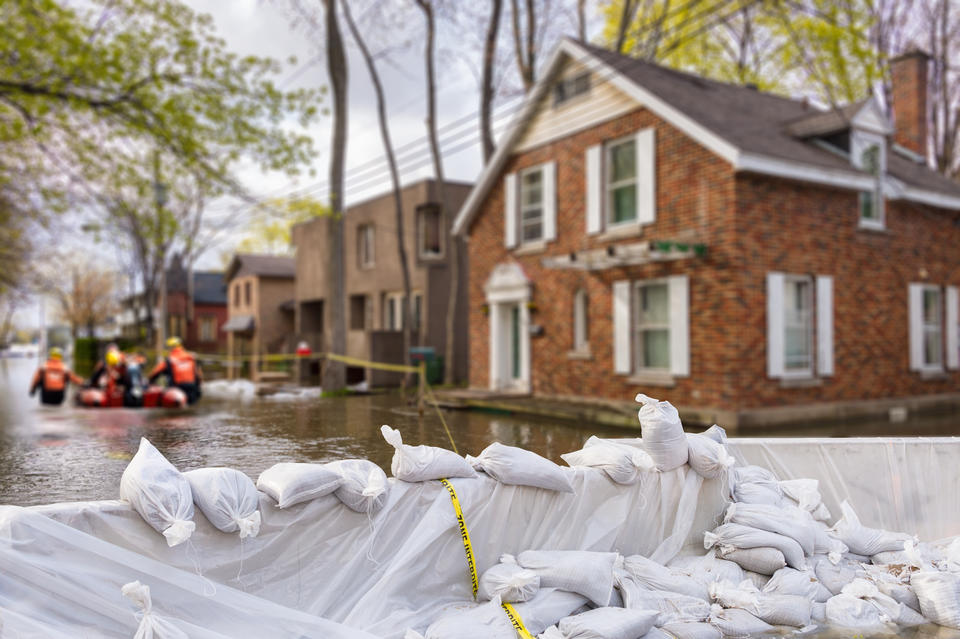In National Climate Assessment, NIST Offers New Insights on Community Resilience and Adaptation

Extreme climate events, such as a flood, can have a devastating compound effect on communities already struggling to adapt to a changing climate.
A major weather event such as a hurricane or wildfire can have lasting, visible impacts on communities, but the longer-term, compounding effects of a changing climate can be harder to see. In its contributions to the recently released Fifth National Climate Assessment (NCA5), the National Institute of Standards and Technology (NIST) highlights ways that communities can adapt and become more resilient as the climate changes.
The NCA5, a congressionally mandated report by multiple U.S. government agencies, analyzes the impacts, risks and responses of global climate change in the United States, and the message is clear: Communities must adapt. To help communities make decisions to improve their resilience, the report provides comprehensive information on how people across the country are experiencing climate change, the risks we face now and in the future, and actions underway to reduce greenhouse gas emissions and build resilience.
The NCA5 takes a much more holistic approach to understanding climate impacts than its previous editions have. For the first time in the report’s multi-decade history, chapters on social equity and environmental justice have been included. Also, for the first time, NIST has several authors contributing to the report, in chapters that explore how communities can adapt to climate change while promoting the fair treatment and meaningful involvement of all affected.
Jennifer Helgeson, a research economist at NIST, worked with experts from across the country to analyze the challenges that low-income and socially vulnerable communities face due to climate change and their possible solutions. “This focus on equity and justice is new ground for the National Climate Assessment,” Helgeson said, noting that previous versions of the report concentrated mainly on the physical sciences related to climate change.
The report details that the adverse effects of climate change are likely to exacerbate social and economic disparities throughout the nation. Historically disadvantaged groups, including the low-income, very young, very old, and communities of color, are disproportionately exposed to our climate-altered world and are expected to bear an even heavier burden in the decades to come.
While adaptation planning and implementation have advanced in the U.S., most adaptation actions to date have been incremental and small in scale. The report indicates that more transformative adaptation will be necessary to adequately address the risks of current and future climate change.
Compounding Crises in the Face of Climate Extremes
Helgeson’s work is deeply intertwined with the economics of community resilience, which includes planning for and responding to climate challenges and extreme weather events.
One of the pressing challenges low-income and socially vulnerable communities face is resource constraints. “Resources cover more than money,” said Helgeson. “Do people have the time and mental space to deal with community resilience planning while basic needs remain unmet?”
For instance, businesses face challenges when preparing for hurricanes and other potential disasters. And if the cost of preparing for an event leaves them financially strained, they may be ill-prepared for the next one.
“The COVID-19 pandemic had a transformative impact on me and other researchers, prompting us to reflect on how resource-strapped communities and businesses grapple with a multitude of challenges, including unexpected crises like the pandemic,” shared Helgeson.
NIST’s Role in Helping Communities Become More Resilient
Helgeson emphasizes the need to consider not only the economic aspects of climate change impacts but also the unique structure of each community. To help ensure that the benefits of adaptation are broadly shared, solutions must emphasize equity and justice, and incorporate a wide range of values and knowledge sources.
For example, a recent study that Helgeson co-authored revealed that eastern North Carolina is facing a critical challenge from flooding events that bring together rain, river and ocean flooding. These “compound” events are more complex and devastating than single-flood incidents and can strain local resources.
Yet, despite limited resources, local emergency managers often have a deeper understanding of their community’s needs than their state and federal counterparts do. The report highlights the emergence, in North Carolina and elsewhere, of local and community-led adaptation efforts. Along with increasing collaboration among city, tribal, state and federal governments, this indicates a movement toward more inclusive and equitable approaches to climate adaptation.
NIST is actively working on addressing climate change and community resilience issues, including initiatives related to integrating climate change work into planning tools for communities. The NIST Community Resilience Planning Guide for Buildings and Infrastructure Systems and companion playbook provides a practical and flexible approach to help all communities improve their resilience by setting priorities. NIST’s Economic Decision Guide Software (EDGe$) online tool and accompanying ASTM standards can help these communities determine how best to allocate resources to manage risks.
NIST’s contributions to the NCA5 highlight the role of economic analysis and interdisciplinary collaboration in addressing climate change and community resilience. Helgeson aims for this work to shed light on the challenges faced by low-income and socially vulnerable communities and the path toward building a more resilient future. As we confront the realities of climate change, the NCA5 calls for local solutions, equitable policies, and community empowerment as essential in safeguarding our future.

